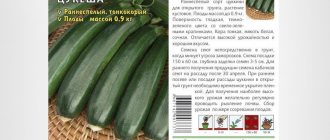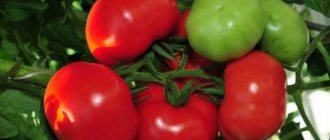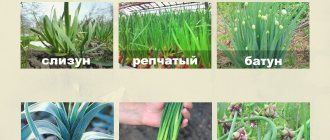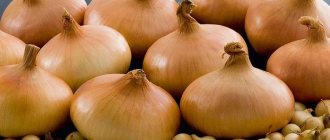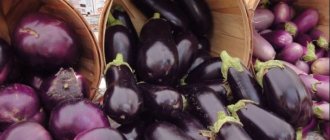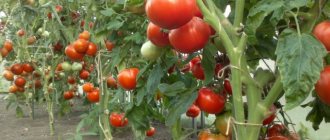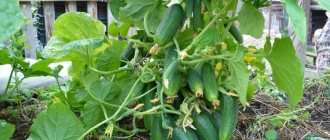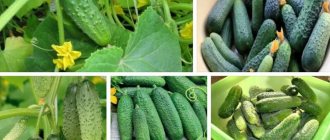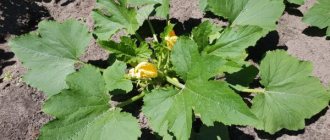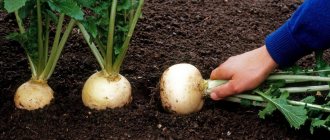Onions (allium) grow in almost every garden. But many people know this plant only as a tasty and medicinal product. But most types of onions are also decorative. Let's get to know them better.
Some types of decorative onions, as a rule, are grown only to decorate the flower garden. We talked about them in the material Decorative onions: photos, names, planting and care. But do not forget that certain types of this useful plant are both decorative and edible. They will transform your garden! And besides, they will not require painstaking care.
Multi-tiered onion
This unusual plant has other names: viviparous onion, walking onion, Canadian onion, horned onion, Egyptian onion. The peculiarity of a multi-tiered onion is that its aerial bulbs, located on a leaning peduncle in 2-3 tiers, take root. Bulbs form on the plant when it is two years old and ripen in mid-summer.
Horned onions are not afraid of frost down to –50°C and short-term spring frosts. It is noteworthy that this perennial crop can grow in one place without replanting for ten years.
Multi-layered onions are mainly grown for making fresh salads. Greens with a medium-sharp taste contain carotene, B and PP vitamins, and the amount of vitamin C in this onion is twice that of onions. Air bulbs have a very pungent taste, so, as a rule, they are not eaten.
The most popular varieties of multi-tiered onions: Gribovsky 38, Odessky winter, Chelyabinsk super early.
Harvest and storage
Most varieties of perennial onions are cultivated for the richness of their greens. The crop is harvested gradually as it ripens, plucking several feathers at a time, or 3-4 total cuttings are carried out over the entire season. When harvesting in large quantities, they use scissors, grabbing the feathers at the very root.
To prolong fruiting, flower shoots are removed from the general green mass of the perennial onion bed.
It is recommended to carry out the final cutting no later than a month before frost. The foliage is stored in the refrigerator in a loosely sealed bag. Typically, feathers feel comfortable in the refrigerator within 10-12 days after being cut from the garden. You can freeze a large amount of feathers for long-term storage; after thawing, the onions retain most of their beneficial properties.
Few varieties of perennials can boast a harvest of bulbs. If this particular option is grown, when harvesting bulbous species, watering must be stopped 2-3 weeks before digging. After removal, the rhizomes are thoroughly dried and carefully discarded before storage. Bulbs are usually stored without removing the husks in a dry room at a temperature no higher than 1 degree.
About the types of perennial onions, about their care and use in decorating flower beds, watch the following video:
Perennial onions are increasingly gaining popularity among gardeners due to the cultivation of new varieties and the unpretentiousness of the crop. Compliance with all growing rules, preventing the appearance of pests and preventing diseases allows you to obtain a lush harvest of perennial onions from one bed for several years.
1
0
Copy link
Branched onion
This perennial plant is native to China and Mongolia. It is also called fragrant onion, fragrant onion, jusai. This onion is drought-resistant, but does not bear fruit without regular watering.
In the year of sowing, a rosette of flat, narrow, succulent leaves about 50 cm long is formed on the plant. They taste similar to garlic leaves. And from the second year, in the second half of summer, the onion produces a tall peduncle (up to 80 cm), on which white star-shaped flowers appear, collected in spherical inflorescences. In winter, branched onions can be grown on a windowsill.
All parts of the plant are edible. The leaves (distinguished by their unique onion-garlic taste), raw and salted, are placed in salads, added to meat, fish, any side dish, and used in the preparation of hot dishes and pies. And the arrows of branched onion flowers are pickled.
The best varieties of branched onions: Fragrant, Dzhusai, Stargazer, Piquant.
Diseases and pests
Even such an unpretentious crop as onions is at risk of infection. The following diseases are dangerous for greenery:
- Downy mildew . Small whitish spots appear on the leaves. Over time, they enlarge and become covered with a purple coating. The feathers begin to turn yellow and dry out. Black mold or mildew appears on them.
- Rust. The feathers are covered with red, raised spots, which turn black over time. Gradually the plant dies.
These diseases are of fungal origin, which specifically harm onion greens. The infection overwinters in soil or plant debris. To prevent infection, attention is paid to disinfecting the soil and garden tools, maintaining crop rotation, and proper watering.
It is important to disinfect the seeds and soil before planting onions. Since greens absorb chemicals that are used to treat fungal diseases, such a crop will be hazardous to health.
super remedy - ammonia - against the onion fly. onion weevil. pray. psyllids
Pests are no less dangerous to the crop. These include:
- Western onion-tailed proboscis. The larvae gnaw yellowish tunnels in the onion feathers. Adult insects go into the ground where they lay new eggs. It is impossible to get rid of a pest that has infected plants. Prevention is considered to be soil disinfection, crop rotation, and removal of plant residues.
- Onion moth. The leaves begin to turn yellow, dry out and wither. The larvae eat the onion inflorescences. Spraying with a solution prepared from a bar of laundry soap and a bucket of water will help fight the pest.
- Onion fly. Lays larvae in the roots of the plant. The leaves become covered with white spots, stop growing, turn yellow and dry out. Adhesive tape and wormwood decoction will help protect plantings from flies.
Leek
This popular onion is also called pearl onion. It has been grown in Russia since the 20th century. In the first year, large lanceolate leaves up to 60 cm long, bluish-green in color with a waxy coating, appear on a thick false stem. A false bulb forms at the bottom of the stem.
In the second year, in the first half of summer, the plant produces a peduncle about a meter high. In July, small flowers of pink, white or lilac-violet color bloom on it, collected in umbrella inflorescences. Black seeds ripen in August-September. And in some varieties, instead of flowers, aerial bulbs are formed.
The young flat leaves and thickened white part of the stem are edible. Old leaves are harsh and lose their taste. In cooking, leeks are used to prepare purees, soups, sauces and salads. It is eaten with meat, scrambled eggs and cheeses. Leeks are suitable for frying, and the onions are good canned with a sweet and sour marinade. The taste of leeks is subtle, sweet and pleasant, and the aroma is delicate.
Popular varieties of leeks: Alligator, Goliath, Pandora, Tango, Karatansky.
Bear onion
Most often, this name combines 2 very similar types: bear onion and victorious onion (victorious). The first is also known under the names wild garlic, wild onion, wild garlic and is listed in the Red Book. The plant is grown from freshly collected seeds, which need stratification.
In the first year, bear onion is attractive for its oblong or lanceolate leaves (about 5 cm wide), which are located on the petioles. And in the second year of life, a peduncle (up to 50 cm high) with hemispherical white inflorescences is formed on the plant. The flowers bloom in May-June, and in July the seeds ripen in their place, and the above-ground part of the plant dies.
Victory onions differ in appearance only by their larger size and longer growing season - until August.
The stem, leaves and bulb of the plant are eaten. Wild garlic leaves taste like garlic and onion greens, they are rich in vitamin C. They are added fresh to salads, soups, vegetables, and also fermented, salted and pickled.
In the middle zone, two varieties of onions are cultivated: Medvezhonok and Bear Delicacy.
Features of growing in open ground
In open ground, gardeners pay minimal attention to crops:
- Watering. The first 6 weeks after sowing the seeds, the beds must be watered. This is done as the top layer of soil dries. Watering should not be abundant so that the water does not stagnate. Only settled water at room temperature is suitable for moistening the soil. Further, the onions are watered only during drought.
- Loosening. After watering, the soil must be loosened. Do this carefully so as not to damage the roots. This procedure destroys the earthen crust, which prevents full air exchange.
- Weeding. Young onions must be weeded. Weeds interfere with the development of plant roots, gradually leading to their death or reducing productivity. It is convenient to do this during the loosening process.
- Thinning. After the appearance of 3 true leaves, the plantings are thinned out. Leave a distance of at least 5 cm between plants.
- Mulching. It is recommended to sprinkle the beds with a layer of peat or fresh straw.
- Feeding. Fertilizing is carried out 2-3 times during the entire period of growing onions. Natural nitrogen fertilizers are suitable for the development of greenery. For example, chicken manure diluted 1:10 with water, silage, ash solution (1 kg of ash per bucket of water).
- Arrows . If the bow throws out its arrows, they break them off. They spoil the taste of greens.
Slime Bow
It is also a ferruginous onion, or drooping onion. This perennial grows well in fertile soil with a neutral reaction. The plant is cold-resistant - leaves sometimes appear from under the snow. They are flat, fleshy, with rounded edges. Their length is about 40 cm, and their width is from 1 to 3 cm. A slimy juice appears on the cut leaves, which is how the plant got its name.
Slime onions have false bulbs (about 2 cm in diameter) that are attached to the rhizome. Over time, the bush grows in width and thins out in the center. Then the plant needs to be divided.
In the first year, only leaves form on the onion, and from the second year (late June - early July) flower stalks appear (about 70 cm high) with spherical inflorescences consisting of pink-white or lilac flowers.
The taste of onion leaves is delicate, with a garlicky flavor. They contain vitamins B1, B2, C, PP, phytoncides, carotene, mineral salts of zinc, potassium, molybdenum, magnesium, and a lot of iron. Slime onions are most often added to fresh salads, soups and main courses, and used as a spice. Greens can also be dried, frozen and pickled, and onions can be pickled.
Popular varieties of slime onions: Green, Dwarf, Leader, Charm.
Methods for growing onions
Cultivation in open ground is not the only method of growing onions. Professional farmers plant it in greenhouses. There is nothing difficult about getting fresh herbs at home.
In the greenhouse
The main criterion for choosing a variety in this case is productivity. To obtain a large mass of greenery in a greenhouse, you need fertile soil. Its surface is sprinkled with dolomite flour or slaked lime - this will prevent mold from developing.
In greenhouses without heating, the bulbs are planted using the bridge method at the very end of autumn, sprinkled with a mixture of humus and peat chips (a layer at least 5–6 cm thick). The mulch is removed in the last ten days of February. The onions are watered with warm water, the beds are covered with plastic film until shoots appear.
In heated greenhouses, it is easier to maintain optimal conditions for forcing feathers - onions need a temperature of 17–20ºС during the day and 13–15ºС at night with a 12-hour daylight hours. When the first shoots appear, the daytime temperature is raised to 21–23ºС, but no more. A feather grows faster in warmth, but stretches greatly.
Growing green onions in a greenhouse is economically justified only on an industrial scale
Ventilation is added to the usual measures for caring for crops in a greenhouse. Special mineral complexes for onions are used as fertilizing. Watering is completely stopped 4-5 days before the planned cutting of greenery.
Video: onions for greens in a greenhouse
On hydroponics
The method is very popular among those who grow herbs for sale; hydroponics allows you to get feathers all year round and save space. The slabs are placed on racks in 3–4 tiers.
The bulbs are planted in special mineral wool slabs or mats, pre-moistened and spilled with a fertilizer solution. The interval between them is about 2 cm, the width of the rows is 3 cm. They are covered with a layer of perlite or vermiculite 2–3 cm thick on top.
When growing green onions hydroponically, it is necessary to provide them with optimal or close to optimal conditions.
Over the next week, the plantings need shade and coolness. As soon as developed roots appear, daylight hours are increased to 12–14 hours, and the temperature is raised to 23–25ºС. Feathers reach a length of 25–30 cm after 12–15 days. Always make sure that the “substrate” remains slightly moist at all times, water it with a fertilizer solution.
Video: green onions in hydroponics
At home
The technology is more or less familiar to everyone. The bulb is placed upside down in a glass of water or planted in a container with a diameter of 7–10 cm. Any universal substrate for seedlings is suitable. You can also use a deep tray to increase the yield. Before emergence, the bulbs are provided with heat (25–30ºС). As soon as the feathers grow to 1.5–2 cm in length, the temperature will need to be lowered to 20–23ºС.
Growing onions in one container is more convenient than in several separate jars
The water in the container is changed every 2-3 days, the substrate is watered twice a week. It is not necessary to apply fertilizing. All the necessary feathers will be obtained from the bulb itself; after cutting off the greens, they simply throw it away. The wait for the harvest is not long - the first feathers appear in a week or even earlier, they reach the required length in 8-12 days. Containers should be kept away from radiators and other heating devices. Otherwise, the soil quickly overheats and feathers grow poorly.
If onions are grown in water at home, make sure that the bottom does not touch its surface, otherwise rot will quickly develop.
You can save space by growing green onions in bottles with the neck cut off. Several 5–8 holes are cut out in the walls of a 5-liter container, matching the diameter of the bulbs. They are inserted inside, soil is poured into the bottle, compacting well. Water the plantings by dipping the container into water.
Onions grow well at home and in sawdust; they retain moisture for a long time, allowing you to get by with 1-2 waterings. Just before planting, they must be doused with boiling water or soaked for several hours in a solution of potassium permanganate for disinfection. Sawdust is used only once: after harvesting, the substrate is completely changed.
Video: growing onions on a windowsill
Onion
Other names for this onion are pipe, tubular, Chinese, Tatar. In early spring, a feather appears in the form of pipes, which can be collected until late autumn. The leaves are large (about 3 cm wide and 40 cm high), covered with a waxy coating. Starting from the second year, in summer, flower stalks (up to 1 m high) with light green or yellowish spherical inflorescences are formed. Later, black seeds ripen in place of the flowers.
Onion prefers fertile soils and does not tolerate waterlogging and high acidity. It grows well in one place for no more than 5 years.
The leaves of this onion contain a large amount of essential oil, which gives them a unique aroma and pungent taste. Feathers are used to prepare salads, spicy (oriental) soups and barbecue.
Common varieties of onion: April, Gribovsky 21, Maisky, Welsh.
Chives
The plant is also called chives. This frost-resistant type of onion begins to grow in early spring and safely withstands frosts down to –4°C. The plant prefers fertile, moist soils with a neutral reaction. To prevent onions from losing their taste and decorative qualities, they need to be divided every 3-4 years.
This plant has small false bulbs that turn into a false stem, an awl-shaped thin green feather up to 40 cm long. It has a weak garlic aroma and a slightly pungent taste without bitterness - ideal for fresh salads.
From the second year, not only greenery appears on the plant, but also thin flower stalks (about 50 cm high) with small inflorescences-balls of pinkish-lilac, red-violet or white color. Flowering is observed in May-June; at the end of summer, onions can bloom again.
The most common varieties of chives: Spring, Moscow, Siberian, Early ripening, Prague.
Shallot
This type of onion also has several names: Ashkelon, multi-lobed, family, magpie. According to one version, the birthplace of shallots is the ancient city of Palestine, and according to another, the Mediterranean.
Externally, the plant is very similar to onions, but shallots produce not just one bulb, but 5-6 (in the first year) and from 15 to 30 (in subsequent years). In this case, the bulbs are collected in a nest.
In the first year, thin cylindrical leaves with a waxy coating appear on the plant, and in the second year, flower stalks (up to 80 cm high) with small white inflorescences appear. In September, black seeds ripen in place of the flowers.
Shallots prefer light, loose, fertile soils with a neutral reaction. The plant tolerates spring frosts down to –4°C well, is well stored, has a delicate and not very pungent taste and a pleasant aroma.
Shallot bulbs hardly cause tears, which is why housewives like them. Chopped onions are added to sauces and salad dressings, sprinkled on baked meat. In addition, chopped onions are fried in olive oil and served as a side dish.
Popular varieties of shallots: Zvezdochka, Knyazhich, Kubansky yellow, Ryzhik, Siberian yellow, Uralsky 40.
Bulb onions
This most popular type of onion is usually grown as a biennial crop. A mature bulb is covered with dry scales of golden yellow, brown, white or purple. The leaves are tubular and succulent. On a hollow peduncle (about 1 m high) in June-August, spherical inflorescences of greenish-white color are formed.
There are many varieties of onions. They differ in terms of cultivation, taste and size of feathers and bulbs, color of scales, etc. Bessonovsky, Danilovsky, Red Baron are very popular.
- 10 best varieties and hybrids of onions (description and photo)
What kind of onions do you prefer to grow - sweet, spicy, colored, white, large, small?
- Which type of onion to choose for the garden?
There are many varieties of onions that are suitable for growing in the garden. Which one should you choose?
- Varieties of onions for forcing
This is simply amazing! Getting fresh onions in winter couldn't be easier!
Features of growing in a greenhouse
Caring for green onions in a greenhouse is not particularly different from growing them in open ground, but it is important to provide suitable conditions indoors:
- Lighting. Since onions are often grown in a greenhouse during the cold season, when the days are short, it is important to equip it with fluorescent lamps. The greenhouse should have light for at least 10 hours a day.
- Location. A greenhouse for growing greens is installed in an open, unshaded area to save on electricity required for lighting.
- Heating. During the cold season, onions are grown only in a heated greenhouse at temperatures up to 15°C.
- Ventilation. It is important to ensure good ventilation in the greenhouse. Otherwise, the roots and greens will begin to rot.
Garlic
Garlic also belongs to the Allium genus. This plant is known to everyone. In the first year, individual cloves grow, and already in the second year, a complex bulb is formed, which consists of cloves covered with a thin film. Garlic also has edible and quite decorative leaves, arrows and flower stalks.
- The best varieties of winter garlic
Do you dream of a good harvest of winter garlic? Do you want to know which variety to choose for this? Find the answer in our material.
- Spring garlic – which variety to choose?
We know why many summer residents plant spring garlic every year and what varieties they prefer. We are ready to tell you too.
How many types of onions decorate your beds? Maybe you grow even more original vegetables in your garden, which are not only tasty and healthy, but also very decorative?
Planting and growing
When planting onions, you should consider its variety. In some cases, it is more preferable to cultivate by seed. But other varieties are planted by selecting seedlings. It is necessary to check that the soil is moist. But under no circumstances should overflow be allowed. In this case, the bulbs will begin to rot.
It is advisable to plant the bulbs in rows, this will make it easier to care for them. You can sit next to each other. It is better not to use pure black soil for growing this crop. It is much better if the soil is sandy. But it is advisable to fertilize it, if not with peat, then at least with ready-made humus. It is important to remember that this plant loves light and warmth, but elevated temperatures are dangerous for it.
Look what crops gardeners from northern Asia managed to grow in a greenhouse in winter.

